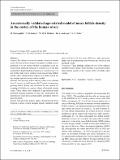Files in this item
An externally validated age-related model of mean follicle density in the cortex of the human ovary
Item metadata
| dc.contributor.author | McLaughlin, Marie | |
| dc.contributor.author | Kelsey, Tom | |
| dc.contributor.author | Wallace, W Hamish B | |
| dc.contributor.author | Anderson, Richard A | |
| dc.contributor.author | Telfer, Evelyn E | |
| dc.date.accessioned | 2015-06-07T21:40:02Z | |
| dc.date.available | 2015-06-07T21:40:02Z | |
| dc.date.issued | 2015-07 | |
| dc.identifier | 187778734 | |
| dc.identifier | 1f5c91d1-1427-455a-a2ad-8b03fc6ee47b | |
| dc.identifier | 26043911 | |
| dc.identifier | 84938991062 | |
| dc.identifier | 26043911 | |
| dc.identifier | 000359454000012 | |
| dc.identifier.citation | McLaughlin , M , Kelsey , T , Wallace , W H B , Anderson , R A & Telfer , E E 2015 , ' An externally validated age-related model of mean follicle density in the cortex of the human ovary ' , Journal of Assisted Reproduction and Genetics , vol. 32 , no. 7 , pp. 1089-1095 . https://doi.org/10.1007/s10815-015-0501-7 | en |
| dc.identifier.issn | 1058-0468 | |
| dc.identifier.other | PubMedCentral: PMC4531872 | |
| dc.identifier.other | ORCID: /0000-0002-8091-1458/work/27201535 | |
| dc.identifier.uri | https://hdl.handle.net/10023/6772 | |
| dc.description.abstract | The population of non-growing follicles present in the ovary is defined as the ovarian reserve. This underpins the reproductive lifespan in women, with its depletion determining age at loss of fertility and the menopause. Data amassed from published results of indirect invasive and non-invasive procedures has resulted in the generation of predictive models which estimate the ovarian reserve from conception throughout adult life. The distribution of follicles in the ovary is not uniform, with the great majority of NGFs located in the cortex, which is the region normally biopsied and used for fertility preservation. Previous models have however analysed whole ovary NGF populations and ovarian volumes, but not cortical NGF density. In this study we compared mean non-growing follicle density values obtained from tissue samples from 13 ovarian cortical biopsies (16-37 years) against age- matched model-predicted values generated from population and ovarian volume models, taking into account the proportion of the ovary that is cortex. A mean non-growing follicle density was calculated for each patient by counting all follicles in a given volume of freshly biopsied ovarian cortical tissue. These values were compared to age-matched model generated densities and the correlation between data sets tested. Non-growing follicle density values obtained from fresh biopsied ovarian cortex samples closely matched model generated data with low mean difference, tight agreement limits and no proportional error between the observed and predicted results. These findings validate the use of the population and ovarian volume models to accurately predict mean follicle density in the ovarian cortex of adult women. | |
| dc.format.extent | 7 | |
| dc.format.extent | 499486 | |
| dc.language.iso | eng | |
| dc.relation.ispartof | Journal of Assisted Reproduction and Genetics | en |
| dc.subject | Adolescent | en |
| dc.subject | Adult | en |
| dc.subject | Aging | en |
| dc.subject | Female | en |
| dc.subject | Humans | en |
| dc.subject | Models, Biological | en |
| dc.subject | Ovarian Follicle | en |
| dc.subject | Ovary | en |
| dc.subject | Reproducibility of Results | en |
| dc.subject | Young Adult | en |
| dc.subject | Journal Article | en |
| dc.subject | Research Support, Non-U.S. Gov't | en |
| dc.subject | QA75 Electronic computers. Computer science | en |
| dc.subject | R Medicine | en |
| dc.subject | NDAS | en |
| dc.subject.lcc | QA75 | en |
| dc.subject.lcc | R | en |
| dc.title | An externally validated age-related model of mean follicle density in the cortex of the human ovary | en |
| dc.type | Journal article | en |
| dc.contributor.sponsor | EPSRC | en |
| dc.contributor.sponsor | EPSRC | en |
| dc.contributor.sponsor | EPSRC | en |
| dc.contributor.institution | University of St Andrews. School of Computer Science | en |
| dc.contributor.institution | University of St Andrews. Centre for Interdisciplinary Research in Computational Algebra | en |
| dc.identifier.doi | 10.1007/s10815-015-0501-7 | |
| dc.description.status | Peer reviewed | en |
| dc.identifier.url | http://link.springer.com/article/10.1007/s10815-015-0501-7/fulltext.html | en |
| dc.identifier.grantnumber | EP/H004092/1 | en |
| dc.identifier.grantnumber | N/A | en |
| dc.identifier.grantnumber | EP/K503940/1 | en |
This item appears in the following Collection(s)
Items in the St Andrews Research Repository are protected by copyright, with all rights reserved, unless otherwise indicated.

